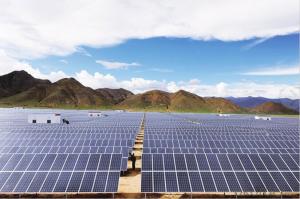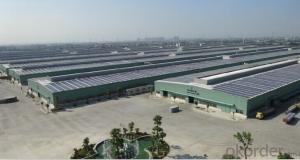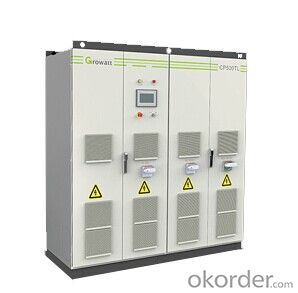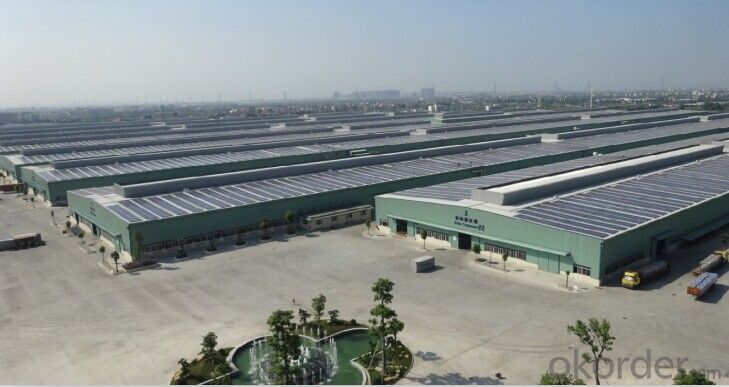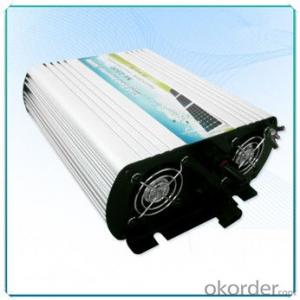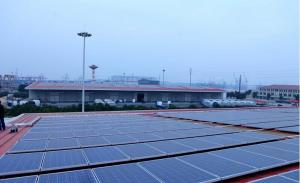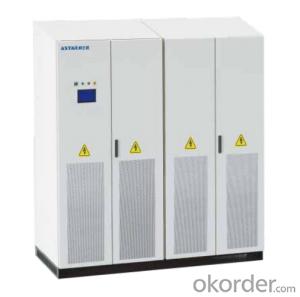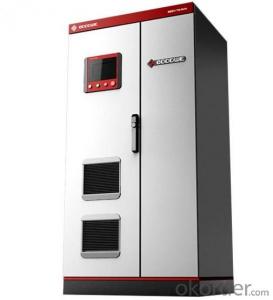50kW Solar Inverter CP500TL, 500kW for Solar Plant
- Loading Port:
- Shekou
- Payment Terms:
- TT OR LC
- Min Order Qty:
- 8 watt
- Supply Capability:
- 10000 watt/month
OKorder Service Pledge
OKorder Financial Service
You Might Also Like
Solar inverter CP500TL, 500kw for Solar Plant
Specifications
Low voltage ride through
Active power continuous adjustment (0-100%)
Reactive power adjustable, PF range 0.9lagging aa 0.9lead
Low voltage ride through
Active power continuous adjustment (0-100%)
Reactive power adjustable, PF range 0.9lagging – 0.9leading
Maximum conversion efficiency of 98.6%
Multi-language touch panel monitoring interface
Rigorous grid environment adaptable
Auxiliary electrical heating (optional)
High altitude application adaptable<6000m (power derating over 3000m)
Certificates and approvals including CE,CGC solar,BDEW etc.
Input Data (DC)
Max. DC power | 575KW |
Max. DC voltage | 1000V |
Full-load MPP-Voltage range | 450V – 820V |
Nominal input voltage | 500V |
Initial voltage/Initial power | 500V/5000W |
Max. input current | 1270A |
Number of MPP trackers | 1 |
Max. number of parallel strings | 16 |
Output Data (AC)
Nominal AC output power | 500KV |
Nominal AC output voltage | 270V |
AC output voltage range | 243V – 297V |
Nominal AC output frequency | 50Hz/60Hz |
AC output frequency range | 45Hz – 55Hz/55Hz – 65Hz |
Max. output current | 1200A |
PF (cosφ) | 0.9lagging – 0.9leading |
THDI | <3%(@pac,r)< p=""> |
Efficiency
Max. conversion efficiency | 98.6% |
Euro-eta | 98.3% |
MPPT efficiency | 99.9% |
Protection
DC disconnection device | yes |
AC disconnection device | yes |
DC Over-voltage protection | Arrester typeⅡ |
AC Over-voltage protection | Arrester typeⅡ |
Grid monitoring/regulation | yes/yes |
PV Isolation detection | yes |
General Data
Dimension (W/H/D) | 2000/2200/850 mm |
Weight | 2000kg |
Operating temperature range | -20°C … +50°C |
Humidity | 15% - 95% |
Protection level | IP20 |
Noise emission | 65dB(A)@1m |
Altitude | 3000m |
Standby power consumption | <100w< p=""> |
Cooling Concept | Forced Air Cooling |
Topology | Transformerless |
Display | LCD Touch Panel |
Communication interface | RS 485/ Ethernet |
Certificate & Approval
Approval | CE/CQC/TUV/BDEW |
- Q: Can a solar inverter be connected to a battery storage system?
- Yes, a solar inverter can be connected to a battery storage system. In fact, this is a common setup in many residential and commercial solar installations. The solar inverter is responsible for converting the direct current (DC) generated by the solar panels into alternating current (AC) that can be used to power electrical appliances. By connecting a battery storage system to the solar inverter, excess energy generated by the solar panels can be stored in the batteries for later use, such as during periods of low sunlight or during power outages. This allows for greater energy independence and the ability to maximize the utilization of solar energy.
- Q: How does a solar inverter communicate with other components of a solar power system?
- A solar inverter communicates with other components of a solar power system through wired or wireless connections. It typically uses communication protocols such as Modbus, CAN bus, or Ethernet to exchange data with devices such as solar panels, batteries, energy meters, and monitoring systems. This communication enables the inverter to receive information about the solar panel's output, battery status, and energy consumption, allowing it to optimize power generation and manage energy flow within the system.
- Q: Can a solar inverter be used for both single-phase and three-phase applications?
- No, a solar inverter cannot be used for both single-phase and three-phase applications. The design and functionality of a solar inverter are specific to either single-phase or three-phase systems.
- Q: Can a solar inverter be used with solar-powered streetlights?
- Yes, a solar inverter can be used with solar-powered streetlights. A solar inverter is responsible for converting the direct current (DC) produced by solar panels into alternating current (AC) that can be used to power various electrical devices, including streetlights. By integrating a solar inverter into the system, solar-powered streetlights can efficiently utilize the energy captured from the sun to illuminate the streets.
- Q: Can a solar inverter convert DC power to AC power during a power outage?
- No, a solar inverter cannot convert DC power to AC power during a power outage. During a power outage, the solar inverter relies on the grid to function, and without grid power, it cannot convert DC power from the solar panels into usable AC power.
- Q: What are the key factors affecting the warranty coverage of a solar inverter?
- The key factors affecting the warranty coverage of a solar inverter include the length of the warranty period, the reputation and reliability of the manufacturer, the quality of the components used in the inverter, any specified usage restrictions or limitations, and the level of technical support and after-sales service provided by the manufacturer.
- Q: Can a solar inverter be used with solar-powered desalination systems?
- Yes, a solar inverter can be used with solar-powered desalination systems. Solar inverters are essential components in solar power systems as they convert the direct current (DC) electricity generated by solar panels into alternating current (AC) electricity that can be used to power various devices, including desalination systems. By connecting the solar panels to a solar inverter, the generated solar energy can be efficiently utilized to power the desalination system, making it a sustainable and environmentally friendly solution for producing fresh water.
- Q: How does a solar inverter handle voltage drop in long cable runs?
- A solar inverter handles voltage drop in long cable runs by compensating for the drop in voltage through a process called voltage regulation. It adjusts the output voltage to ensure that the required voltage level is maintained at the point of connection to the solar panels. This allows for efficient power transmission and ensures that the system operates optimally despite the voltage drop caused by long cable runs.
- Q: How does a solar inverter handle voltage and frequency variations caused by voltage sags and swells?
- Voltage and frequency variations caused by voltage sags and swells are effectively managed by the diverse mechanisms equipped in a solar inverter. When there is a voltage sag or swell in the electrical grid, the solar inverter employs a technique known as Maximum Power Point Tracking (MPPT) to regulate the power output from the solar panels. During a voltage sag, where the grid voltage drops below the standard level, the solar inverter adjusts its MPPT algorithms to ensure that the solar panels continue operating at their maximum power point. This guarantees that the inverter extracts the most available power from the panels and compensates for the reduced grid voltage. By dynamically adjusting the operating point of the panels, the inverter mitigates the effects of the voltage sag and maintains an optimal power output. Similarly, in the case of a voltage swell, where the grid voltage exceeds the normal level, the solar inverter once again utilizes its MPPT capabilities to regulate power output. It adjusts the panels' operating point to prevent them from surpassing their rated voltage, thereby safeguarding them from potential damage. This allows the inverter to effectively handle the increased grid voltage and prevent any negative impact on the solar panels. Aside from voltage regulation, a solar inverter also addresses frequency variations caused by voltage sags and swells. It is designed to synchronize with the grid frequency and uphold a stable output frequency. When the grid frequency deviates from the normal range, the inverter adapts its internal control systems to match the grid frequency. This synchronization ensures that the power output from the inverter aligns with the grid requirements, facilitating seamless integration of solar energy into the electrical system. In conclusion, a solar inverter effectively manages voltage and frequency variations caused by voltage sags and swells by utilizing MPPT algorithms, voltage regulation mechanisms, and frequency synchronization capabilities. These features enable the inverter to adapt to changing grid conditions, maximize power extraction from the solar panels, and maintain a stable and reliable power output.
- Q: How does the input voltage rating affect the performance of a solar inverter?
- The input voltage rating is a critical factor in determining the performance of a solar inverter. The inverter's ability to convert the direct current (DC) generated by solar panels into alternating current (AC) for use in homes or businesses depends on the input voltage rating. If the input voltage rating of the inverter is not compatible with the voltage produced by the solar panels, the inverter may not function properly or may even be damaged. Thus, selecting an inverter with the correct input voltage rating is essential for optimal performance and longevity of a solar power system.
Send your message to us
50kW Solar Inverter CP500TL, 500kW for Solar Plant
- Loading Port:
- Shekou
- Payment Terms:
- TT OR LC
- Min Order Qty:
- 8 watt
- Supply Capability:
- 10000 watt/month
OKorder Service Pledge
OKorder Financial Service
Similar products
Hot products
Hot Searches
Related keywords

